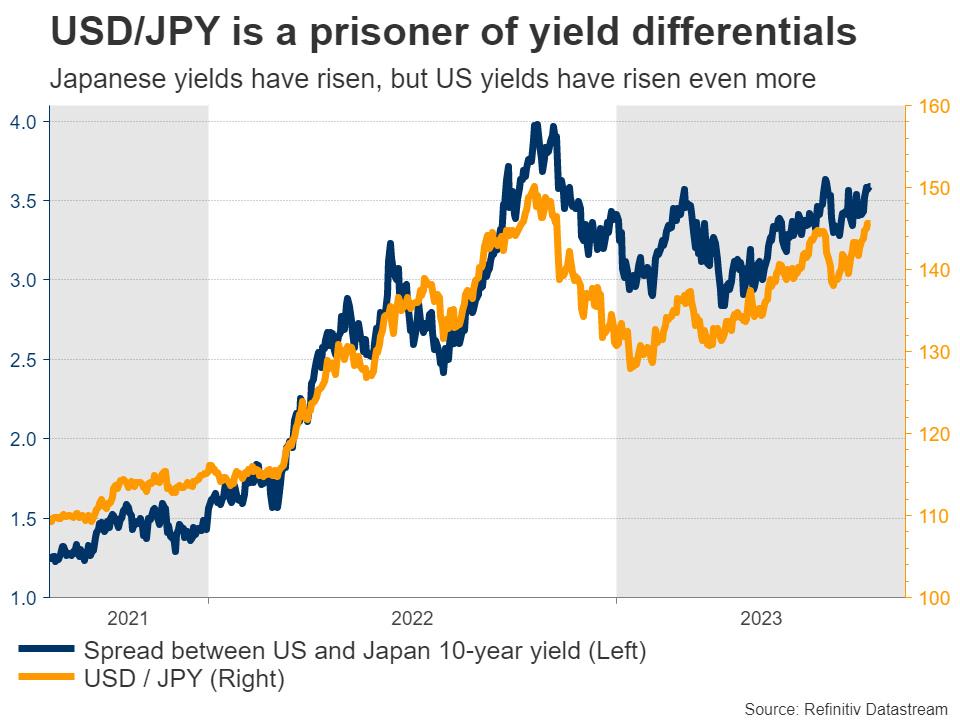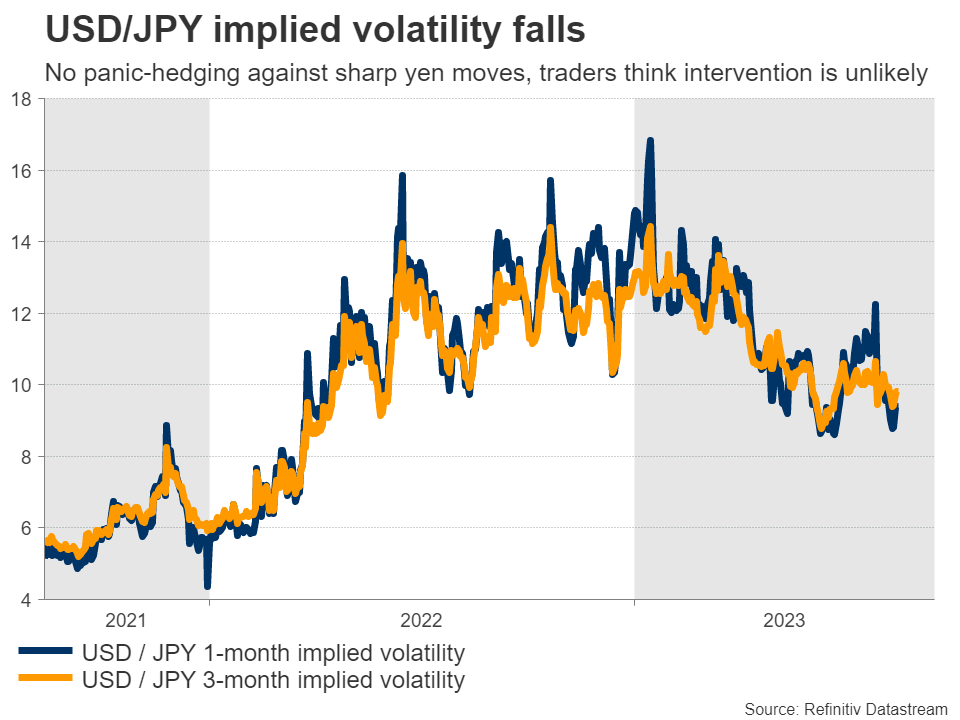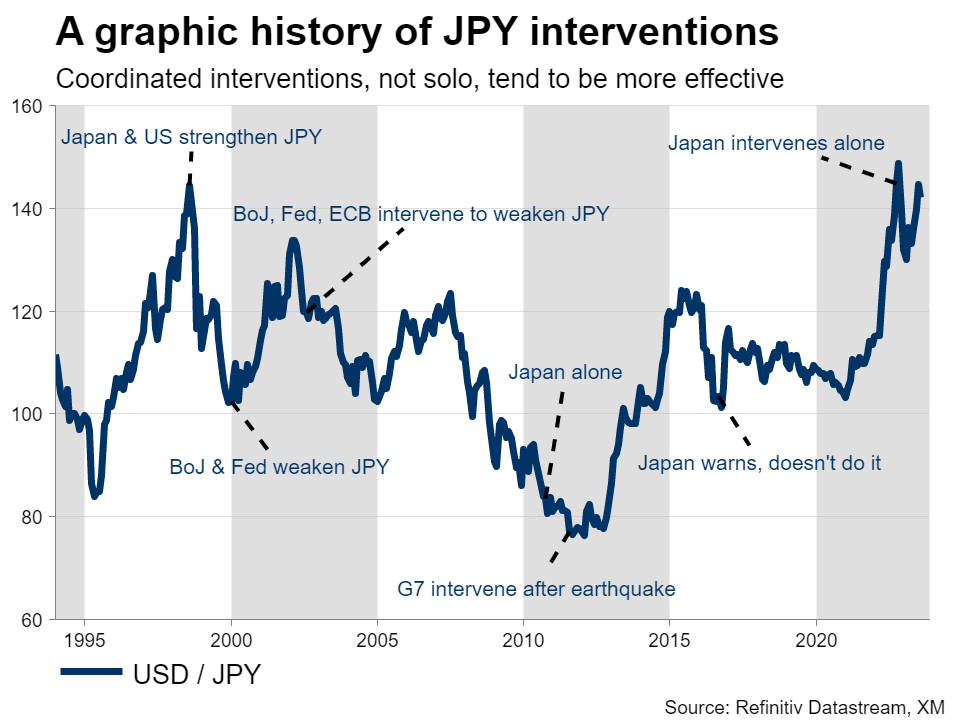Will Japan intervene to rescue the battered yen?
 Soaring energy prices have also inflicted damage on the yen through the trade channel. Japan imports nearly all of its oil and gas, so higher energy prices have deprived the nation from its trade surplus. Although this negative effect dissipated earlier this year as a weaker yen boosted exports and oil prices fell, it might become more pronounced again following the latest rally in oil prices, which started in late June and therefore hasn't been captured in the data yet. In other words, capital and trade flows have both moved against the yen recently, and the fallout is reflected in the charts. So why is FX intervention unlikely?The main argument against FX intervention is that Japanese authorities have not threatened it lately. There haven’t been many concerned comments about exchange rates from government officials in recent weeks, even as the yen fell to the ‘danger zone’ that the government decided to defend last year. Tokyo has been relatively silent, and sometimes silence can speak volumes. Before real intervention takes place, there will be several verbal warnings from various officials. It’s a cost-free method to discourage speculators from attacking the yen. Speed matters a lot in this calculation. One reason why Tokyo seems more relaxed this time is that the pace of the yen’s depreciation is not as severe as last year. A slow and orderly drop is very different from a rapid breakdown in the currency. Policymakers ultimately want to preserve stability. Another reason is the latest policy tweak by the Bank of Japan. With the central bank finally taking the first steps towards normalizing policy, there is less concern about a chaotic yen collapse that requires intervention.
Soaring energy prices have also inflicted damage on the yen through the trade channel. Japan imports nearly all of its oil and gas, so higher energy prices have deprived the nation from its trade surplus. Although this negative effect dissipated earlier this year as a weaker yen boosted exports and oil prices fell, it might become more pronounced again following the latest rally in oil prices, which started in late June and therefore hasn't been captured in the data yet. In other words, capital and trade flows have both moved against the yen recently, and the fallout is reflected in the charts. So why is FX intervention unlikely?The main argument against FX intervention is that Japanese authorities have not threatened it lately. There haven’t been many concerned comments about exchange rates from government officials in recent weeks, even as the yen fell to the ‘danger zone’ that the government decided to defend last year. Tokyo has been relatively silent, and sometimes silence can speak volumes. Before real intervention takes place, there will be several verbal warnings from various officials. It’s a cost-free method to discourage speculators from attacking the yen. Speed matters a lot in this calculation. One reason why Tokyo seems more relaxed this time is that the pace of the yen’s depreciation is not as severe as last year. A slow and orderly drop is very different from a rapid breakdown in the currency. Policymakers ultimately want to preserve stability. Another reason is the latest policy tweak by the Bank of Japan. With the central bank finally taking the first steps towards normalizing policy, there is less concern about a chaotic yen collapse that requires intervention.  Of course, this narrative could change if the yen continues to sink, especially if the decline accelerates in speed. But for now, the risk of actual intervention is low and investors appear to agree, judging by the decline in USD/JPY implied volatility. This means the big players are not really hedging against any massive moves in the yen. The buzzwords that would suggest Tokyo is ready to take action would be government officials describing FX moves as ‘disorderly’ or ‘one-sided’. The minister of finance - Shunichi Suzuki - is the final authority in intervention matters, so hearing those words from him would be the tell. Suzuki made some comments this week, but he only said that the government would respond to “excessive” moves. The fact that he hasn’t ramped up his warnings suggests we are still some distance away from actual FX intervention. What’s the line in the sand? It’s difficult to say exactly where Tokyo might draw the line and step in, because that line is a moving target, which changes depending on the speed of FX moves. A slow decline might not be very concerning, but a sharp and violent drop would be. Looking at the USD/JPY chart, the most important area to watch is 150, which is where the second round of intervention took place last year. The tone of Japanese officials as we approach this region will reveal whether they intend to defend it again.
Of course, this narrative could change if the yen continues to sink, especially if the decline accelerates in speed. But for now, the risk of actual intervention is low and investors appear to agree, judging by the decline in USD/JPY implied volatility. This means the big players are not really hedging against any massive moves in the yen. The buzzwords that would suggest Tokyo is ready to take action would be government officials describing FX moves as ‘disorderly’ or ‘one-sided’. The minister of finance - Shunichi Suzuki - is the final authority in intervention matters, so hearing those words from him would be the tell. Suzuki made some comments this week, but he only said that the government would respond to “excessive” moves. The fact that he hasn’t ramped up his warnings suggests we are still some distance away from actual FX intervention. What’s the line in the sand? It’s difficult to say exactly where Tokyo might draw the line and step in, because that line is a moving target, which changes depending on the speed of FX moves. A slow decline might not be very concerning, but a sharp and violent drop would be. Looking at the USD/JPY chart, the most important area to watch is 150, which is where the second round of intervention took place last year. The tone of Japanese officials as we approach this region will reveal whether they intend to defend it again.  All told, for the yen to mount a lasting recovery, it would probably need some crisis or recession in foreign economies that fuels bets for rate cuts abroad, helping to compress yield differentials. Europe and China are certainly losing steam, although the United States economy remains resilient. Solo intervention can slow the depreciation, but is unlikely to change the yen’s trend by itself. And since the Bank of Japan doesn’t seem to have much appetite for a continued tightening campaign, the yen is once again left in the hands of external forces - namely how global yields perform.
All told, for the yen to mount a lasting recovery, it would probably need some crisis or recession in foreign economies that fuels bets for rate cuts abroad, helping to compress yield differentials. Europe and China are certainly losing steam, although the United States economy remains resilient. Solo intervention can slow the depreciation, but is unlikely to change the yen’s trend by itself. And since the Bank of Japan doesn’t seem to have much appetite for a continued tightening campaign, the yen is once again left in the hands of external forces - namely how global yields perform. Related Assets
Latest News
Disclaimer: The XM Group entities provide execution-only service and access to our Online Trading Facility, permitting a person to view and/or use the content available on or via the website, is not intended to change or expand on this, nor does it change or expand on this. Such access and use are always subject to: (i) Terms and Conditions; (ii) Risk Warnings; and (iii) Full Disclaimer. Such content is therefore provided as no more than general information. Particularly, please be aware that the contents of our Online Trading Facility are neither a solicitation, nor an offer to enter any transactions on the financial markets. Trading on any financial market involves a significant level of risk to your capital.
All material published on our Online Trading Facility is intended for educational/informational purposes only, and does not contain – nor should it be considered as containing – financial, investment tax or trading advice and recommendations; or a record of our trading prices; or an offer of, or solicitation for, a transaction in any financial instruments; or unsolicited financial promotions to you.
Any third-party content, as well as content prepared by XM, such as: opinions, news, research, analyses, prices and other information or links to third-party sites contained on this website are provided on an “as-is” basis, as general market commentary, and do not constitute investment advice. To the extent that any content is construed as investment research, you must note and accept that the content was not intended to and has not been prepared in accordance with legal requirements designed to promote the independence of investment research and as such, it would be considered as marketing communication under the relevant laws and regulations. Please ensure that you have read and understood our Notification on Non-Independent Investment. Research and Risk Warning concerning the foregoing information, which can be accessed here.